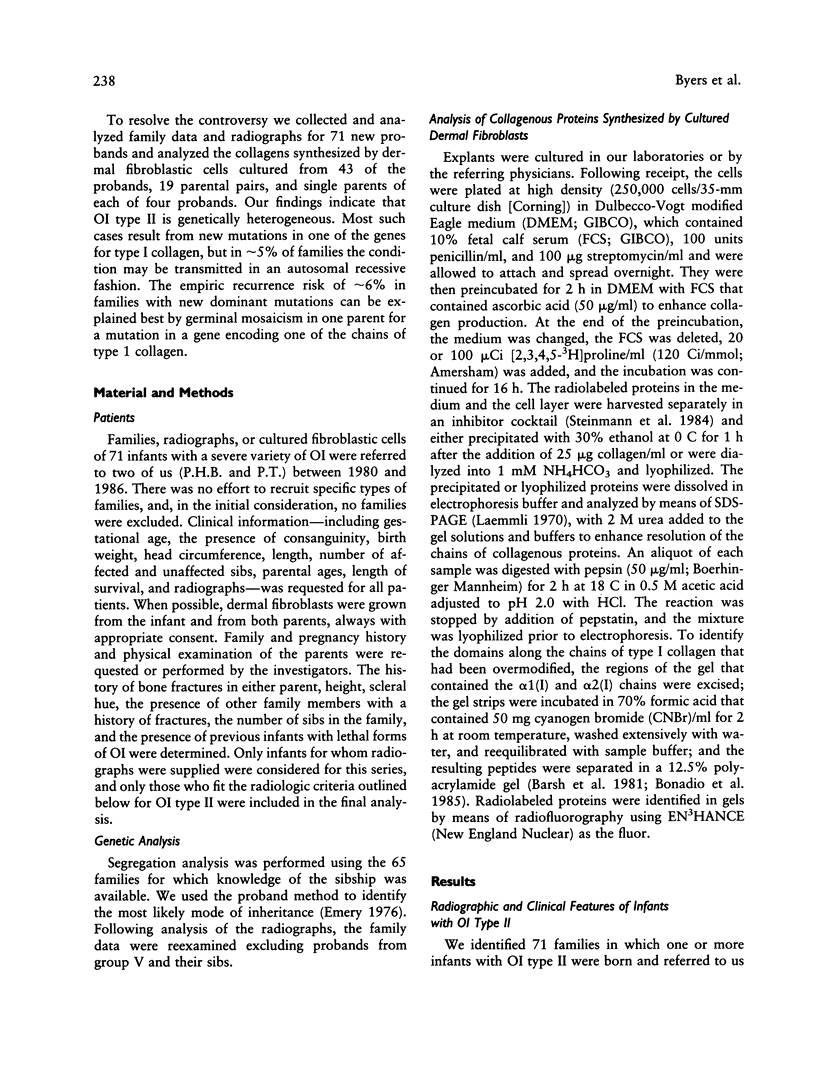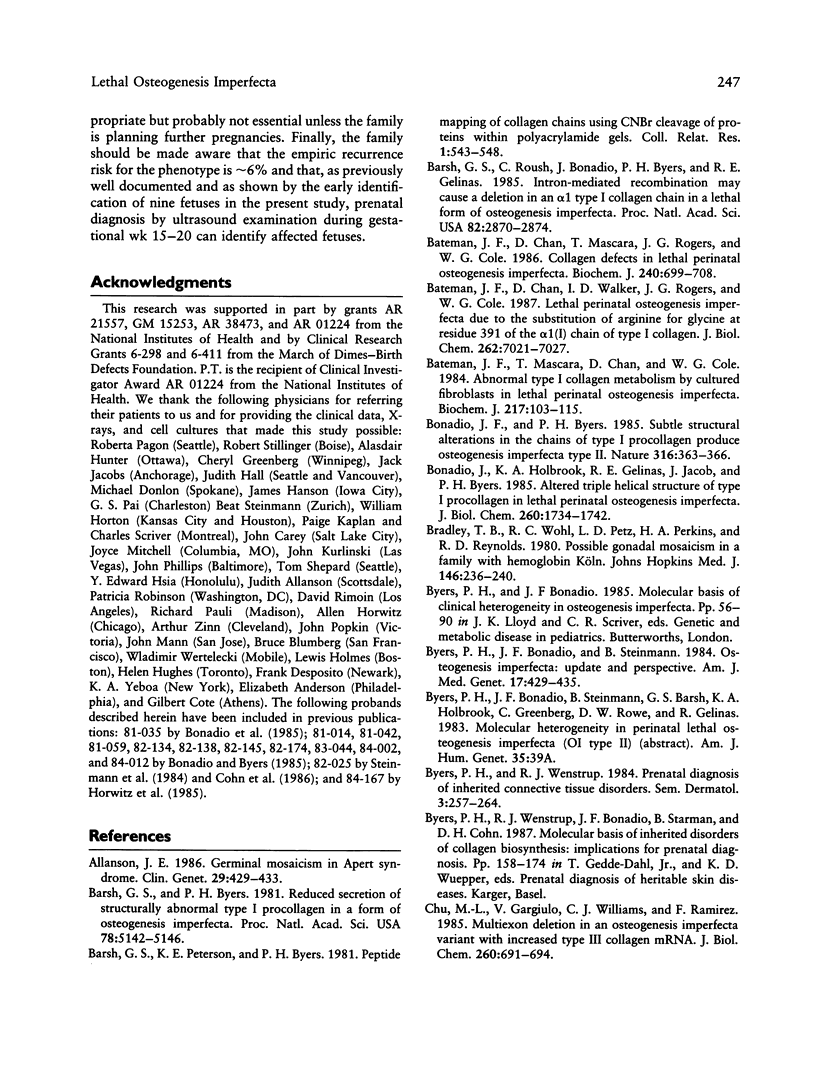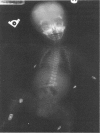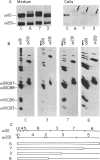Abstract
To resolve uncertainty concerning the inheritance of the perinatal lethal form of osteogenesis imperfecta (OI type II), we collected family data and radiographs for 71 probands and analyzed the collagens synthesized by dermal fibroblastic cells cultured from 43 of the probands, 19 parental pairs, and single parents of each of four additional probands. In 65 families for which there were complete data on sibship size, there was recurrence of the OI type II phenotype in five families such that six (8.6%) of 70 sibs were affected. In two families with recurrence, the radiographic phenotype was milder than that for the remainder; and one of those families was consanguinous, suggesting autosomal recessive inheritance. In the remaining three families there was no evidence of consanguinity, but in one of them the structure was compatible with gonadal mosaicism in the mother. In studies of collagens synthesized by cells from 43 infants, we identified two probands with separate rearrangements in an allele of one of the genes of type I collagen; but in the rest there were subtle mutations that disrupted the normal triple-helix structure of type I collagen molecules. In two probands we identified de novo mutations; in 16 additional families cells from the parents made only normal collagens, compatible with new mutations in their offsprings. These findings indicate that the OI type II phenotype is biochemically heterogeneous, that the majority result from new dominant mutations in the genes encoding type I collagen, and that some recurrences can be accounted for by gonadal mosaicism in one of the parents.
Full text
PDF











Images in this article
Selected References
These references are in PubMed. This may not be the complete list of references from this article.
- Allanson J. E. Germinal mosaicism in Apert syndrome. Clin Genet. 1986 May;29(5):429–433. doi: 10.1111/j.1399-0004.1986.tb00516.x. [DOI] [PubMed] [Google Scholar]
- Barsh G. S., Byers P. H. Reduced secretion of structurally abnormal type I procollagen in a form of osteogenesis imperfecta. Proc Natl Acad Sci U S A. 1981 Aug;78(8):5142–5146. doi: 10.1073/pnas.78.8.5142. [DOI] [PMC free article] [PubMed] [Google Scholar]
- Barsh G. S., Peterson K. E., Byers P. H. Peptide mapping of collagen chains using CNBr cleavage of proteins within polyacrylamide gels. Coll Relat Res. 1981 Nov;1(6):543–548. doi: 10.1016/s0174-173x(81)80035-0. [DOI] [PubMed] [Google Scholar]
- Barsh G. S., Roush C. L., Bonadio J., Byers P. H., Gelinas R. E. Intron-mediated recombination may cause a deletion in an alpha 1 type I collagen chain in a lethal form of osteogenesis imperfecta. Proc Natl Acad Sci U S A. 1985 May;82(9):2870–2874. doi: 10.1073/pnas.82.9.2870. [DOI] [PMC free article] [PubMed] [Google Scholar]
- Bateman J. F., Chan D., Mascara T., Rogers J. G., Cole W. G. Collagen defects in lethal perinatal osteogenesis imperfecta. Biochem J. 1986 Dec 15;240(3):699–708. doi: 10.1042/bj2400699. [DOI] [PMC free article] [PubMed] [Google Scholar]
- Bateman J. F., Chan D., Walker I. D., Rogers J. G., Cole W. G. Lethal perinatal osteogenesis imperfecta due to the substitution of arginine for glycine at residue 391 of the alpha 1(I) chain of type I collagen. J Biol Chem. 1987 May 25;262(15):7021–7027. [PubMed] [Google Scholar]
- Bateman J. F., Mascara T., Chan D., Cole W. G. Abnormal type I collagen metabolism by cultured fibroblasts in lethal perinatal osteogenesis imperfecta. Biochem J. 1984 Jan 1;217(1):103–115. doi: 10.1042/bj2170103. [DOI] [PMC free article] [PubMed] [Google Scholar]
- Bonadio J., Byers P. H. Subtle structural alterations in the chains of type I procollagen produce osteogenesis imperfecta type II. Nature. 1985 Jul 25;316(6026):363–366. doi: 10.1038/316363a0. [DOI] [PubMed] [Google Scholar]
- Bonadio J., Holbrook K. A., Gelinas R. E., Jacob J., Byers P. H. Altered triple helical structure of type I procollagen in lethal perinatal osteogenesis imperfecta. J Biol Chem. 1985 Feb 10;260(3):1734–1742. [PubMed] [Google Scholar]
- Bradley T. B., Wohl R. C., Petz L. D., Perkins H. A., Reynolds R. D. Possible gonadal mosaicism in a family with hemoglobin Köln. Johns Hopkins Med J. 1980 Jun;146(6):236–240. [PubMed] [Google Scholar]
- Byers P. H., Bonadio J. F., Steinmann B. Osteogenesis imperfecta: update and perspective. Am J Med Genet. 1984 Feb;17(2):429–435. doi: 10.1002/ajmg.1320170206. [DOI] [PubMed] [Google Scholar]
- Byers P. H., Wenstrup R. J., Bonadio J. F., Starman B., Cohn D. H. Molecular basis of inherited disorders of collagen biosynthesis: implications for prenatal diagnosis. Curr Probl Dermatol. 1987;16:158–174. doi: 10.1159/000413463. [DOI] [PubMed] [Google Scholar]
- Chu M. L., Gargiulo V., Williams C. J., Ramirez F. Multiexon deletion in an osteogenesis imperfecta variant with increased type III collagen mRNA. J Biol Chem. 1985 Jan 25;260(2):691–694. [PubMed] [Google Scholar]
- Chu M. L., Williams C. J., Pepe G., Hirsch J. L., Prockop D. J., Ramirez F. Internal deletion in a collagen gene in a perinatal lethal form of osteogenesis imperfecta. Nature. 1983 Jul 7;304(5921):78–80. doi: 10.1038/304078a0. [DOI] [PubMed] [Google Scholar]
- Cohn D. H., Byers P. H., Steinmann B., Gelinas R. E. Lethal osteogenesis imperfecta resulting from a single nucleotide change in one human pro alpha 1(I) collagen allele. Proc Natl Acad Sci U S A. 1986 Aug;83(16):6045–6047. doi: 10.1073/pnas.83.16.6045. [DOI] [PMC free article] [PubMed] [Google Scholar]
- David T. J. Dominant ectrodactyly and possible germinal mosaicism. J Med Genet. 1972 Sep;9(3):316–320. doi: 10.1136/jmg.9.3.316. [DOI] [PMC free article] [PubMed] [Google Scholar]
- Fryns J. P., Kleczkowska A., Verresen H., van den Berghe H. Germinal mosaicism in achondroplasia: a family with 3 affected siblings of normal parents. Clin Genet. 1983 Sep;24(3):156–158. doi: 10.1111/j.1399-0004.1983.tb02232.x. [DOI] [PubMed] [Google Scholar]
- Laemmli U. K. Cleavage of structural proteins during the assembly of the head of bacteriophage T4. Nature. 1970 Aug 15;227(5259):680–685. doi: 10.1038/227680a0. [DOI] [PubMed] [Google Scholar]
- REED T. E., FALLS H. F. A pedigree of aniridia with a discussion of germinal mosaicism in man. Am J Hum Genet. 1955 Mar;7(1):28–38. [PMC free article] [PubMed] [Google Scholar]
- RUSSELL W. L. X-ray-induced mutations in mice. Cold Spring Harb Symp Quant Biol. 1951;16:327–336. doi: 10.1101/sqb.1951.016.01.024. [DOI] [PubMed] [Google Scholar]
- Searle A. G. Evidence from mutable genes concerning the origin of the germ line. Basic Life Sci. 1978;12:209–224. doi: 10.1007/978-1-4684-3390-6_16. [DOI] [PubMed] [Google Scholar]
- Shapiro J. E., Phillips J. A., 3rd, Byers P. H., Sanders R., Holbrook K. A., Levin L. S., Dorst J., Barsh G. S., Peterson K. E., Goldstein P. Prenatal diagnosis of lethal perinatal osteogenesis imperfecta (OI type II). J Pediatr. 1982 Jan;100(1):127–133. doi: 10.1016/s0022-3476(82)80252-7. [DOI] [PubMed] [Google Scholar]
- Sillence D. O., Barlow K. K., Garber A. P., Hall J. G., Rimoin D. L. Osteogenesis imperfecta type II delineation of the phenotype with reference to genetic heterogeneity. Am J Med Genet. 1984 Feb;17(2):407–423. doi: 10.1002/ajmg.1320170204. [DOI] [PubMed] [Google Scholar]
- Sillence D. O., Senn A., Danks D. M. Genetic heterogeneity in osteogenesis imperfecta. J Med Genet. 1979 Apr;16(2):101–116. doi: 10.1136/jmg.16.2.101. [DOI] [PMC free article] [PubMed] [Google Scholar]
- Soriano P., Jaenisch R. Retroviruses as probes for mammalian development: allocation of cells to the somatic and germ cell lineages. Cell. 1986 Jul 4;46(1):19–29. doi: 10.1016/0092-8674(86)90856-1. [DOI] [PubMed] [Google Scholar]
- Steinmann B., Rao V. H., Vogel A., Bruckner P., Gitzelmann R., Byers P. H. Cysteine in the triple-helical domain of one allelic product of the alpha 1(I) gene of type I collagen produces a lethal form of osteogenesis imperfecta. J Biol Chem. 1984 Sep 10;259(17):11129–11138. [PubMed] [Google Scholar]
- Williams C. J., Prockop D. J. Synthesis and processing of a type I procollagen containing shortened pro-alpha 1(I) chains by fibroblasts from a patient with osteogenesis imperfecta. J Biol Chem. 1983 May 10;258(9):5915–5921. [PubMed] [Google Scholar]
- Young I. D., Harper P. S. Recurrence risk in osteogenesis imperfecta congenita. Lancet. 1980 Feb 23;1(8165):432–432. doi: 10.1016/s0140-6736(80)90988-5. [DOI] [PubMed] [Google Scholar]
- Young I. D., Thompson E. M., Hall C. M., Pembrey M. E. Osteogenesis imperfecta type IIA: evidence for dominant inheritance. J Med Genet. 1987 Jul;24(7):386–389. doi: 10.1136/jmg.24.7.386. [DOI] [PMC free article] [PubMed] [Google Scholar]
- de Wet W. J., Pihlajaniemi T., Myers J., Kelly T. E., Prockop D. J. Synthesis of a shortened pro-alpha 2(I) chain and decreased synthesis of pro-alpha 2(I) chains in a proband with osteogenesis imperfecta. J Biol Chem. 1983 Jun 25;258(12):7721–7728. [PubMed] [Google Scholar]





